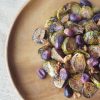
Become a ‘fruitie’ with these four exotic and nutritious fruits
By Linda Bonvie | 0 Comments | Posted 09/10/2015
It wasn’t that long ago that produce mainstays like kiwis, mangoes and papayas were total bafflers in the produce section, never before seen or tasted. With the success of exotic fruits like those, along with improvements in shipping, the hunt for the next new money fruit is offering experimental shoppers some odd items to try out.
The pitiya, commonly sold under the flashier name dragon fruit, is a looker to be sure. It is bright red to purplish on the outside, with a seedy white inside.
Grown in Asia, Mexico, Central and South America, and Israel, dragon fruit is roughly the size of an orange, though elongated. The taste is generally sweetish, a kind of cross between pear and, oddly, a turnip.
Chock full of vitamins (B and C), calcium, minerals and antioxidants, it is easily eaten by simply halving and spooning out the inside meat. The plentiful seeds are small, fully digestible and high in polyunsaturated fats.
One of the showier exotics, one seemingly destined for stardom, is the starfruit.
It is a native of Asia but is now being cultivated in many warmer climates, worldwide. This tender yellow fruit is, indeed, star-shaped, best seen when cross-sliced, skin and all.
The starfruit offers a subtle, sweet and juicy flavor, which has been compared to that of both apples and grapes.
When sliced, the fruit’s limited seeds can easily be removed, and the brown skin around the high-point edges trimmed off. Less discerning munchers, however, can eat the whole thing — dark skin, seeds and all.
Star fruit is a good source of vitamin C, meaning it qualifies as one of those year-round fruits, able to help to stave off winter colds and flus. It is also rich in fiber and comes in at only about 30 calories per fruit.
Passionfruit, while still a rarity, is known to turn up every so often in produce sections to the delight of those who know it from trips to the tropics, where it is often consumed “in the wild.” It ranges in hue from yellow to purple depending on the type. The purple varieties are generally sweeter.
It is also one of seediest – and gushiest – of all tropical fruits. In fact, a test for passionfruit ripeness is to shake it and listen for sloshing inside, meaning the deliciousness has been loosed.
Getting through the tough rind of a passionfruit requires a knife with serrated edge. After being placed on a glass dish, it can be cut crosswise, longwise or near the top, via a slow sawing motion. The trick is to conserve any of the juicy innards from being lost, as can sometimes happen when using a cutting board.
The insides of an opened passionfruit can be spooned out and eaten, seeds and all. The fruit can also be added to drinks or used in sauce, jellies, and syrups, which requires processing out the seeds.
The pulp of the passionfruit offer a delicious citrusy flavor, both sweet and sour. As with many exotic fruits, it has its own flavor, which can vary from fruit to fruit. It is a very good source of dietary fiber, vitamins C and A, along with potassium, iron, copper, magnesium and phosphorus.
The lychee, sometimes referred to as the lychee nut, is one of the most beloved fruits in all of Asia, which is saying a lot. In America, it has been introduced through Asian restaurants.
With roots in the Guangdong and Fujian provinces of China, the lychee tree is now being grown in many other tropical to semitropical areas of the world, including sections of the US. Nonetheless, demand greatly exceeds the harvest. Due to its traditional usage in Asian celebrations and the Chinese New Year, a premium is often paid for fresh lychee.
Once past the fruits leathery red skin, the fresh fruit has a soft almost gelatinous opaque white pulp, around a large mahogany color seed. In fact, a lychee has as much seed as pulp. As to flavor, the lychee rates near the very top for many folks. It offers a hint of Concord grape but is significantly sweeter — and highly fragrant. In fact, many lychee fans describe it as “Tasting like a rose smells.”
Along with hosting a great deal of tradition, the lychee also carries many health benefits, being particularly strong on the Vitamin C front. Ten lychee fruits easily meet an adult’s daily requirement of C. The fruit also offers dietary fiber, vitamins, and antioxidants. In Asian medicine, it is seen as bringing a cooling effect to the body.
To eat a lychee, simply peel off the rough red skin and free the pulpy fruit. Pop it in your mouth but don’t bite down overly hard since fully half the fruit is the pithy, slippery seed inside.
And yes, a lychee tree can be started from the seed.


 Contact us
Contact us



























